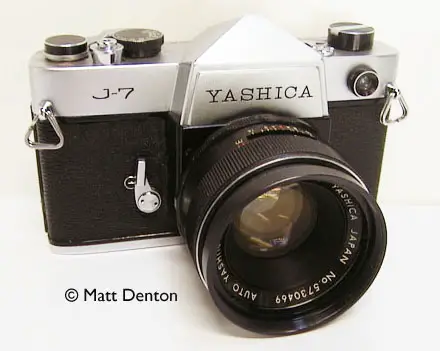- Produced 1968 Yashica Co., Ltd. Japan
- Film type 135 (35mm)
- Picture size 24mm x 36mm
- Weight 24oz (680.4g) body only; with Auto Yashinon normal lens 2.0 lbs (907.2g)
- Lens M42 screw mount Auto Yashinon GX 50mm 1:1.7-16
- Filter size 52mm
- Shutter rubberized focal plane
- Shutter speeds B, 1-1/1000
- Viewfinder SLR
- Exposure meter body-mounted CdS with top window readout
- Battery originally PX625 (for meter only)
- two PC sync (one for X, one for M)
- Self-timer
Overview
This camera comes from the same wonderful collection (read: estate) as my TL-Super and Electro Shot. I had been keeping my eye out for more auctions from this collection and was lucky enough to secure this classic. This early Yashica SLR is the seventh revision of a line that began in 1961 with the Penta J. Sources place the production year of this model at 1968. I was skeptical since it’s lacking in some of the sophistication of the 1966 TL-Super but I have it on good authority from a fellow that bought one at a PX in DaNang Vietnam (!) in 1968 and is still using it. (!!)
It’s a basic SLR with most of the features we know today as standard, and some that aren’t: speeds B-1000, pentaprism, etc. However the shoe is not a hot shoe but an add-on accessory shoe that slips onto the eyepiece (reminds me a bit of the Contaflex shoe). And the (uncoupled?) meter is not TTL but is in the body (left shoulder, if you will) with the readout not in the viewfinder but on top of the camera, linked to the ASA setting dial and shutter speed selector (see below). Again reminds me of the Contaflex II, except that instead of selenium this is a battery-powered button-activated CdS in a kind of transitional hybrid. There is also a battery check button.

The Auto-Yashinon DX 1:1.7 is a large, sharp and fast beauty with an interesting focusing style that again seems to predate even the Auto-Yashinon DX 1:1.7 on the TL-Super: the nameplate on the front of the lens remains stationary while a metal extension moves in and out around it. It’s a little strange, I’ve not seen anything like it. Other than that I think the specs on the lens are the same as on the TL-Super, 6 elements in 5 groups, coated, Auto feature, opens from f16-f1.7, and focuses down to 1 1/2 feet.
Repairs
The camera came to me in very nice shape, but the light seals will need replacing eventually as will the foam bumper for the mirror.
Tips & Tricks
The screw mount is the same as the old Pentax screw mount (M42), which means you can use the nice old Takumar and Rikenon lenses on this classic.
This camera used a PX625 1.3v battery for the meter – now discontinued – but seems to work just fine with the modern 1.5v alkaline equivalent. Note that the meter is button-activated so I expect a battery would last a long time. I checked it vs. sunny-16 not an actual meter but it seems as accurate as my own calculations. Speaking of battery, the battery chamber has a rubber grommet and the cover has the shallowest slot I’ve seen yet, the combination of which meant that this was one of the most difficult to remove battery covers yet. Once I got it off I put some synthetic grease on the threads (try this on any wonky cover) and now it’s smooth like silk.
The Auto in Auto Yashinon refers to a switch-enabled feature on the lens that allows the aperture to stay wide open until the shutter clicks, a standard feature on all modern lenses. Setting from ‘auto’ to ‘manual’ amounts to an aperture preview feature. With this camera you get that anyway as it closes down to the chosen aperture upon pressing the shutter release halfway, which is why you get two clicks for the price of one when pressing the shutter release.
The wind lever has a long stroke that for me tends to catch on the shoulder strap when I’m in a hurry. Better to use multiple short strokes rather than a long single stroke, it will stop automatically when the shutter is properly tensioned. I find it goes much faster to pump it a few times quickly than do the long stroke and risk catching the lever on the shoulder strap.
Related Links
- CA DeGroot’s Yashica SLR homepage
- Nice Yashica timeline at the M42 mount site
- Batteries Plus has a handy battery chart for all the old Yashica & Contax cameras
